Spin Currents Cool a Quantum Dot
Thanks to the ongoing miniaturization of electronic components, computers that once filled entire rooms are now easily contained within the palm of a hand. But waste heat generated by small components can be difficult to remove. A technique that could work for cooling nanosized magnetic materials is to take away heat with a spin-carrying current, according to calculations reported in Physical Review Letters.
Michael Thorwart at the University of Hamburg, Germany, and his collaborators propose a scheme that makes use of magnetomechanical coupling, in which the magnetic state of a material affects its vibrational energy (and vice versa). This coupling has been demonstrated in nanoscale objects such as a magnetic molecule attached to a carbon nanotube.
Inspired by such systems, Thorwart and his team considered a model magnetic quantum dot connected to two ferromagnetic leads functioning as a “source” and “drain” for electrons. When an electron tunnels onto the dot from the leads, its spin can point up or down. The researchers showed that when the source and the drain had antiparallel magnetic polarizations, a tunneling electron undergoes a spin-flip transition, flipping the direction of the local magnetic moment antiparallel to the magnetic field. Ohmic heating from the ensuing vibrational transitions can then be reduced by flipping the magnetic moment again. For certain coupling parameters, the researchers found that the effective vibrational temperature of the quantum dot could be reduced by more than a factor of 2 from its equilibrium value. The technique could be useful for cooling magnetic dots used as logic units in molecular-scale circuits. – Katherine Kornei
Correction (18 August 2014): After publication of the Synopsis, we became aware of a similar paper presenting the idea of cooling a nanoscale material with a spin current. See P. Stadler et al., “Ground-State Cooling of a Carbon Nanomechanical Resonator by Spin-Polarized Current,” Phys. Rev. Lett. 113, 047201 (2014).





